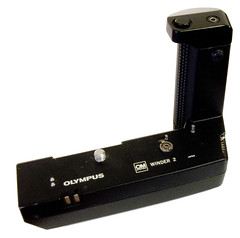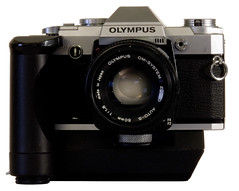Difference between revisions of "Film advance"
m (minor heading) |
(image added) |
||
| Line 36: | Line 36: | ||
|image= http://farm1.static.flickr.com/58/198740138_e062b4c04b_m.jpg | |image= http://farm1.static.flickr.com/58/198740138_e062b4c04b_m.jpg | ||
|image_align= right | |image_align= right | ||
| − | |image_text= OM-30 with winder 2 fitted | + | |image_text= [[Olympus OM-10/20/30/40|OM-30]] with winder 2 fitted |
| + | }} | ||
| + | |{{Flickr_image | ||
| + | |image_source= http://www.flickr.com/photos/lewiscollard/3420325209/in/pool-camerapedia | ||
| + | |image= http://farm4.static.flickr.com/3317/3420325209_d62df16af9_m.jpg | ||
| + | |image_align= right | ||
| + | |image_text= [[Canon A-1]] with Winder A | ||
}} | }} | ||
|} | |} | ||
[[category: Camera parts]] | [[category: Camera parts]] | ||
Revision as of 20:28, 8 April 2009
Film advance is a mechanism for moving film from one spool to another incrementally one frame at a time.
Advance may be a manual process, and may be called winding, advance, wind-on and various other terms, and may use, for example, a knob, key, lever, slider or thumbwheel. For this method there must be some way of stopping winding when the next frame is reached; typical methods are the red window, or some more positive method where the camera has a roller or sprockets measuring the film to stop the winding at the correct point - or the film has a single hole locating the frame, as in 110 and 126 cartridge films.
Some cameras used more eccentric methods, such as the Werra and Agimatic, which had a ring around the lens for winding, or the Bencini Unimatic, where the shutter release button was pushed sideways to wind, and the Voigtländer Vitessa and Welta Penti - equipped with plungers.
In many cameras, the film advance process also cocks the shutter, and, frequently, releasing the shutter unlocks the film advance - providing double-exposure protection.

|
| falling plate mechanism of the Conley Quick Shot |
Falling Plate
A few plate cameras - magazine cameras - (e.g. the Houghton Klito No.1) adopted a "falling plate" arrangement, where a number of plates were kept in a sprung magazine, usually behind the focal plane. After exposure, the exposed plate fell forward and down into a well, allowing the next one to move forward for use.
A related system had a magazine of plates, but a sliding mechanism to move them to the focal plane and back.
Motor Drive
Many cameras - particularly later ones - have some form of automated wind-on, triggered by the shutter release. These use a clockwork mechanism (e.g. the Robot cameras or the Kodak Instamatic X-45; see Category:Spring motor), or an electric motor. On a number of SLR systems, there were add-on motor-wind devices (motor drives) produced between the 1960s and 1990s.
|
|
|


